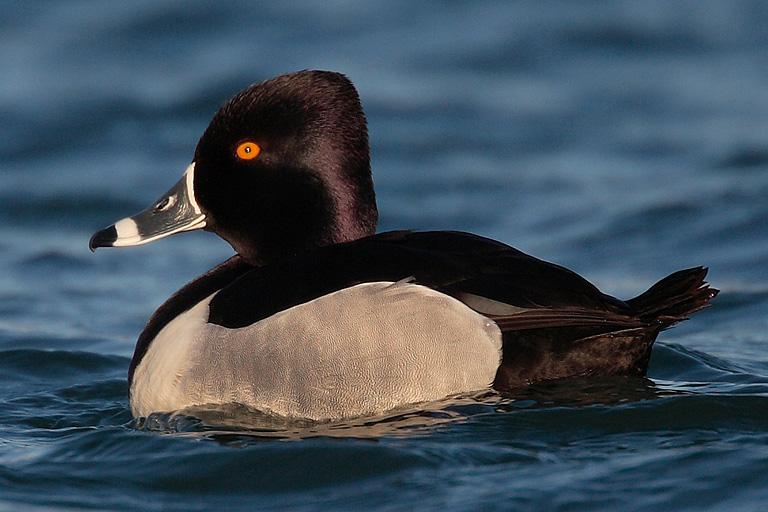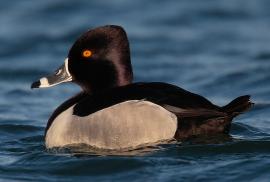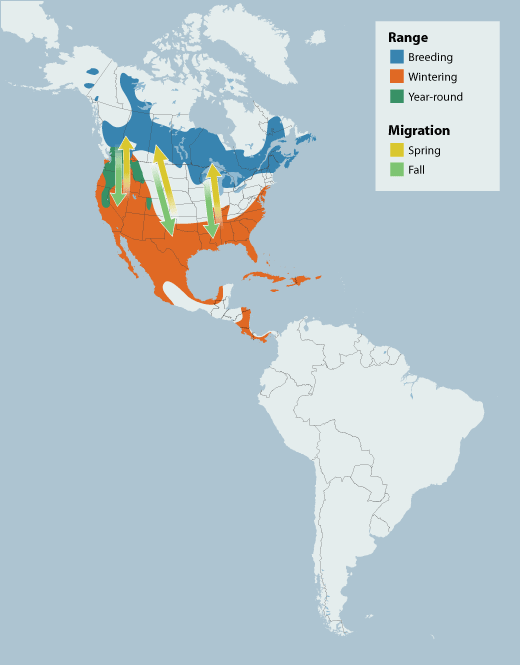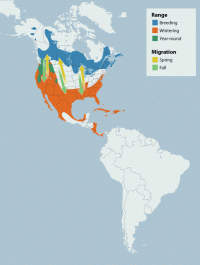Guide to Boreal Birds
This is an in-depth boreal species profile.
What is this?
This species is one of more than 30 birds selected for in-depth profiles. Find out why and see all selected boreal birds »
Overview
The Ring-necked Duck is misleadingly named for the chestnut coloured ring around the black neck of the breeding male, which is barely visible when identifying birds in the field. Its chestnut neck ring is usually seen only at close range, while the white ring on the bill can be a prominent field mark. This species is sometimes mistaken for some of its diving duck relatives, like Lesser and Greater Scaup, but there are key differences to distinguish them. A breeding male Ring-necked Duck's black back, white triangle in front of the folded wing, angular shaped head, white bars on the bill, and uniformly dark wings contrast with the grey back, rounded head, plain bill, and white line on the wing of the Scaup. The female closely resembles Scaup and Redhead females, with the exception of an angular head, white band near the bill tip, and white-eye ring. More partial to acid ponds and lakes in wooded regions than other diving ducks, the Ring-necked Duck eats the seeds of aquatic plants as well as snails and insects. Because it never gathers in large flocks it has not been hunted extensively like some of its relatives. A fast flier, it undertakes longer migrations than most other diving ducks. This bird predominately breeds in the western boreal forest, and is dependent on boreal wetlands for its continued reproductive success.
Description
14-18" (36-46 cm). Male has black back and breast; purple-glossed, black-appearing angular head; pale gray flanks; vertical white mark on side of breast. Female brownish, paler around base of bill, with narrow white eye ring. Bill pale gray with white ring. The high angular shape of the head and white ring on bill distinguish this bird from the scaup.
Voice
Soft purring notes, but usually silent.
Nesting
8-12 buff or olive eggs in a down-lined cup concealed in vegetation near the edge of a pond.
Habitat
Unique to diving ducks, Ring-necked Ducks prefer shallow wetlands fringed with emergent, submerged or floating vegetation like wild celery, bulrush, pondweed and pond lily. They are generally shallow divers when feeding, so do not require deep water. Unlike many other divers, the Ring-necked Duck can take off from a puddle without having to run along the water's surface, and flies swiftly and erratically in small compact groups – possibly a result of the small woodland wetlands it inhabits during breeding. Wintering Ring-necked Ducks can be found on wild rice lakes or other shallow wetlands rich with submerged or emergent plants.
Range/Migration
Ring-necked Ducks are midseason migrants, arriving to the breeding grounds from late March and mid-May, depending on the destination. Fall migration occurs from late September to early December. Males are first to depart in the fall, with females and young following. The bulk of travel takes place at night in smaller flocks than most other duck species form. They migrate inland, to wintering areas stretching from the Pacific, Gulf, and southern Atlantic states, as far as central Mexico and the Caribbean.
Breeding
The core breeding area is within the closed boreal forest of the Northwest Territories, Alberta, Saskatchewan and Manitoba. The eastern boreal region of Canada and the U.S. also contains key breeding areas, but not in the numbers observed in the west. Year-round resident birds breed as far south as California, Colorado and Arizona. The prairie pothole region is largely avoided by breeding Ring-necked Ducks. Pair bonding usually occurs during spring migration, so unpaired ducks arriving on the breeding grounds are likely non-breeders.
Females build nests over water in emergent vegetation on wetland fringes, usually consisting of sedges and woody plants like leatherleaf. When a female Ring-necked Duck first begins laying eggs, she will have built a loose platform of nest material, which develops in size and structure as laying proceeds. When they are completed, nests require constant maintenance to prevent flooding. An average of 9 eggs are laid, and are incubated for 25-29 days. The male may accompany the female from feeding areas to the nest during egg laying, but does not stay to defend the nest, and the pair bond abates soon after she starts incubating. There is no evidence of territoriality in this species, and even ducklings are the most docile of all diving ducks. The female hides her brood in emergent vegetation along the wetland edge, unlike other diver broods that are commonly seen in open water.
Diet/Feeding Behavior
Feeding by shallow dives, as well as dabbling at or just under the surface, Ring-necked Ducks are more generalized feeders than other diving ducks. They eat mostly plant matter like seeds and tubers of submerged vegetation, but also feed on snails, insects, leeches, and other aquatic invertebrates. The diet varies for females during high energy cost periods, such as egg production and nesting, when they will consume more protein rich invertebrates. Young ducklings depend on animal matter exclusively, but as they reach maturity they gradually shift to a diet made up of mostly plants.
References
Bellrose, F.C. 1980. Ducks, geese, and swans of North America. Rev. ed. Stackpole Books, Harrisburg, PA.
Hohman, W.L., and R.T. Eberhardt. 1998. Ring-necked Duck. In The Birds of North America, No. 329 (A. Poole and F. Gill, Eds.). Philadelphia: The Academy of Natural Sciences; Washington, D.C.: The American Ornithologists' Union.
Wilkins, K.A. and M.C. Otto. 2003. Trends in Duck Breeding Populations, 1955-2003. Administrative report. U.S. Fish and Wildlife Service, Division of Migratory Bird Management, Laurel, MD.
USGS Patuxent Wildlife Research Center. 2003. The North American Breeding Bird Survey, Results and Analysis 1966 - 2003. Version 2003.1 (Draft). USGS Patuxent Wildlife Research Center, Laurel, MD, USA.
Nelson, C.G. 1993. The Downy Waterfowl of North America. Delta Station Press, Deerfield, IL and Portage la Prairie, MB.
Credits
Birding content provided by National Wildlife Federation/eNature, with support from Ducks Unlimited/The Pew Charitable Trusts.





